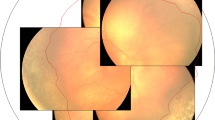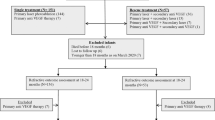Abstract
Objectives
To evaluate corneal topography in full-term and preterm children with or without retinopathy of prematurity (ROP).
Methods
We enrolled children aged from 2 years to 12 years between January 2019 and May 2021 in the following four groups: full-term (group 1), premature without ROP (group 2), untreated premature with ROP (group 3), and laser-treated and/or intravitreal injection (IVI) of anti-vascular endothelial growth factor (VEGF)-treated premature with ROP (group 4). Corneal topography was measured with the Galilei Placido-dual Scheimpflug analyzer G4 every half year, and was compared among the groups using generalized estimating equation models at approximately 7 years of age.
Results
We included 77, 178, 45, and 131 participants in groups 1, 2, 3, and 4, respectively. The mean (standard deviation) number of visits per patient was 2.9 (1.4). Compared with full-term eyes, premature eyes demonstrated steeper anterior corneal curvature (p = 0.016 and p = 0.008 for the mean and steep K, respectively), higher anterior and posterior corneal astigmatism (p = 0.036 and p = 0.016, respectively), and thinner thinnest pachymetry (p < 0.001). The laser-treated ROP eyes displayed steeper anterior corneal curvature (p = 0.040 for steep K) and higher anterior corneal astigmatism (p = 0.005) than the IVI-treated eyes. Moreover, they exhibited high cone location and magnitude index (1.96) reaching the cut-off for detecting keratoconus (1.82).
Conclusions
The premature status led to greater corneal ectasia, and laser treatment for ROP caused further corneal steepness. Higher anterior corneal astigmatism was associated with laser treatment. The ROP pathology and IVI anti-VEGF treatment exerted a marginal effect on corneal topography.
This is a preview of subscription content, access via your institution
Access options
Subscribe to this journal
Receive 18 print issues and online access
$259.00 per year
only $14.39 per issue
Buy this article
- Purchase on Springer Link
- Instant access to full article PDF
Prices may be subject to local taxes which are calculated during checkout
Similar content being viewed by others
Data availability
The datasets used and/or analysed during the current study are available from the corresponding author on reasonable request.
References
Kim SJ, Port AD, Swan R, Campbell JP, Chan RVP, Chiang MF. Retinopathy of prematurity: a review of risk factors and their clinical significance. Surv Ophthalmol. 2018;63:618–37.
Blencowe H, Lawn JE, Vazquez T, Fielder A, Gilbert C. Preterm-associated visual impairment and estimates of retinopathy of prematurity at regional and global levels for 2010. Pediatr Res. 2013;74:35–49.
O’Connor AR, Stephenson T, Johnson A, Tobin MJ, Moseley MJ, Ratib S, et al. Long-term ophthalmic outcome of low birth weight children with and without retinopathy of prematurity. Pediatrics. 2002;109:12–8.
Chen TC, Tsai TH, Shih YF, Yeh PT, Yang CH, Hu FC, et al. Long-term evaluation of refractive status and optical components in eyes of children born prematurely. Invest Ophthalmol Vis Sci. 2010;51:6140–8.
O’Connor AR, Stephenson TJ, Johnson A, Tobin MJ, Ratib S, Fielder AR. Change of refractive state and eye size in children of birth weight less than 1701 g. Br J Ophthalmol. 2006;90:456–60.
Bhatti S, Paysse EA, Weikert MP, Kong L. Evaluation of structural contributors in myopic eyes of preterm and full-term children. Graefes Arch Clin Exp Ophthalmol. 2016;254:957–62.
Fieß A, Kölb-Keerl R, Knuf M, Kirchhof B, Blecha C, Oberacher-Velten I, et al. Axial length and anterior segment alterations in former preterm infants and full-term neonates analyzed with Scheimpflug imaging. Cornea. 2017;36:821–7.
Zhu X, Zhao R, Wang Y, Ouyang L, Yang J, Li Y, et al. Refractive state and optical compositions of preterm children with and without retinopathy of prematurity in the first 6 years of life. Medicine. 2017;96:e8565.
Hittner HM, Rhodes LM, McPherson AR. Anterior segment abnormalities in cicatricial retinopathy of prematurity. Ophthalmology. 1979;86:803–16.
Wu WC, Lin RI, Shih CP, Wang NK, Chen YP, Chao AN, et al. Visual acuity, optical components, and macular abnormalities in patients with a history of retinopathy of prematurity. Ophthalmology. 2012;119:1907–16.
Dunne MC, Royston JM, Barnes DA. Posterior corneal surface toricity and total corneal astigmatism. Optom Vis Sci. 1991;68:708–10.
Savini G, Næser K. An analysis of the factors influencing the residual refractive astigmatism after cataract surgery with toric intraocular lenses. Invest Ophthalmol Vis Sci. 2015;56:827–35.
Reinstein DZ, Archer TJ, Gobbe M. Corneal epithelial thickness profile in the diagnosis of keratoconus. J Refract Surg. 2009;25:604–10.
Quinn GE, Dobson V, Davitt BV, Wallace DK, Hardy RJ, Tung B, et al. Progression of myopia and high myopia in the Early Treatment for Retinopathy of Prematurity study: findings at 4 to 6 years of age. J AAPOS. 2013;17:124–8.
Randleman JB, Woodward M, Lynn MJ, Stulting RD. Risk assessment for ectasia after corneal refractive surgery. Ophthalmology. 2008;115:37–50.
Early Treatment For Retinopathy Of Prematurity Cooperative Group. Revised indications for the treatment of retinopathy of prematurity: results of the early treatment for retinopathy of prematurity randomized trial. Arch Ophthalmol. 2003;121:1684–94.
International Committee for the Classification of Retinopathy of Prematurity. The International classification of retinopathy of prematurity revisited. Arch Ophthalmol. 2005;123:991–9.
Kocamış Sİ, Çakmak HB, Çağıl N, Toklu Y. Investigation of the efficacy of the cone location and magnitude index in the diagnosis of keratoconus. Semin Ophthalmol. 2016;31:203–9.
Chang SHL, Lee YS, Wu SC, See LC, Chung CC, Yang ML, et al. Anterior chamber angle and anterior segment structure of eyes in children with early stages of retinopathy of prematurity. Am J Ophthalmol. 2017;179:46–54.
Lambert SR, Capone A Jr, Cingle KA, Drack AV. Cataract and phthisis bulbi after laser photoablation for threshold retinopathy of prematurity. Am J Ophthalmol. 2000;129:585–91.
Kumawat D, Sahay P, Goel S, Kumar V, Chandra P. Oculodigital phenomenon leading to advanced keratoconus in retinopathy of prematurity - A case report. Delhi J Ophthalmol. 2019;30:46–8.
Chen YC, Chen SN. Foveal microvasculature, refractive errors, optical biometry and their correlations in school-aged children with retinopathy of prematurity after intravitreal antivascular endothelial growth factors or laser photocoagulation. Br J Ophthalmol. 2020;104:691–6.
Lee YS, See LC, Chang SH, Wang NK, Hwang YS, Lai CC, et al. Macular structures, optical components, and visual acuity in preschool children after intravitreal bevacizumab or laser treatment. Am J Ophthalmol. 2018;192:20–30.
Olsen T. On the calculation of power from curvature of the cornea. Br J Ophthalmol. 1986;70:152–4.
Karel I. Acute keratoconus as a complication of retrolental fibroplasia. Cesk Oftalmol. 1969;25:347–51.
Lorfel RS, Sugar HS. Keratoconus associated with retrolental fibroplasia. Ann Ophthalmol. 1976;8:449–50.
Kogoleva LV, Pleskova AV. Keratoconus in children with retinopathy of prematurity (clinical cases). Vestn Oftalmol. 2012;128:32–4.
Kong Q, Ming WK, Mi XS. Refractive outcomes after intravitreal injection of antivascular endothelial growth factor versus laser photocoagulation for retinopathy of prematurity: a meta-analysis. BMJ Open. 2021;11:e042384.
Santhiago MR, Giacomin NT, Smadja D, Bechara SJ. Ectasia risk factors in refractive surgery. Clin Ophthalmol. 2016;10:713–20.
Santhiago MR, Smadja D, Gomes BF, Mello GR, Monteiro ML, Wilson SE, et al. Association between the percent tissue altered and post-laser in situ keratomileusis ectasia in eyes with normal preoperative topography. Am J Ophthalmol. 2014;158:87–.e1.
Fledelius HC. Pre-term delivery and subsequent ocular development. A 7-10 year follow-up of children screened 1982-84 for ROP. 3) Refraction. Myopia of prematurity. Acta Ophthalmol Scand. 1996;74:297–300.
Fielder AR, Quinn GE. Myopia of prematurity: nature, nurture, or disease. Br J Ophthalmol. 1997;81:2–3.
Benavente-Pérez A, Nour A, Troilo D. Axial eye growth and refractive error development can be modified by exposing the peripheral retina to relative myopic or hyperopic defocus. Invest Ophthalmol Vis Sci. 2014;55:6765–73.
Smith EL, Hung LF, Arumugam B. Visual regulation of refractive development: insights from animal studies. Eye. 2014;28:180–8.
Mutti DO, Sinnott LT, Mitchell GL, Jones-Jordan LA, Moeschberger ML, Cotter SA, et al. Relative peripheral refractive error and the risk of onset and progression of myopia in children. Invest Ophthalmol Vis Sci. 2011;52:199–205.
Smith EL, Ramamirtham R, Qiao-Grider Y, Hung LF, Huang J, Kee CS, et al. Effects of foveal ablation on emmetropization and form-deprivation myopia. Invest Ophthalmol Vis Sci. 2007;48:3914–22.
Munro RJ, Fulton AB, Chui TY, Moskowitz A, Ramamirtham R, Hansen RM, et al. Eye growth in term- and preterm-born eyes modeled from magnetic resonance images. Invest Ophthalmol Vis Sci. 2015;56:3121–31.
Mintz-Hittner HA, Kennedy KA, Chuang AZ. Efficacy of intravitreal bevacizumab for stage 3+ retinopathy of prematurity. N. Engl J Med. 2011;364:603–15.
Acknowledgements
The authors would like to thank Ping-Hsuan, Huang for the statistical assistance and wish to acknowledge the support of the Maintenance Project of the Center for Big Data Analytics and Statistics (Grant CLRPG3D0049) at the Chang Gung Memorial Hospital for the study design and the monitoring, data analysis, and interpretation.
Funding
This study was supported by grants from the Chang Gung Memorial Hospital (CMRPG3M0131~2 and CMRPG3L0151~3) and the Ministry of Science and Technology, Taiwan (MOST 109-2314-B-182A-019-MY3).
Author information
Authors and Affiliations
Contributions
PYW was responsible for data analysis, interpretation of results, and draft manuscript preparation. HCC contributed to conceptualization, methodology, interpretation of results, and draft manuscript preparation. YJH contributed to conceptualization and methodology. KJC, NKW, LL, YPC, YSH, and CCL contributed to data collection and interpretation of results. WCW contributed to conceptualization, methodology, and supervision and review of the manuscript. All authors reviewed the results and approved the final version of the manuscript.
Corresponding author
Ethics declarations
Competing interests
The authors declare no competing interests.
Additional information
Publisher’s note Springer Nature remains neutral with regard to jurisdictional claims in published maps and institutional affiliations.
Rights and permissions
Springer Nature or its licensor (e.g. a society or other partner) holds exclusive rights to this article under a publishing agreement with the author(s) or other rightsholder(s); author self-archiving of the accepted manuscript version of this article is solely governed by the terms of such publishing agreement and applicable law.
About this article
Cite this article
Wu, PY., Chen, HC., Hsueh, YJ. et al. Corneal topography in preterm children aged 2 years to 12 years with or without retinopathy of prematurity. Eye 37, 2565–2572 (2023). https://doi.org/10.1038/s41433-022-02375-x
Received:
Revised:
Accepted:
Published:
Issue Date:
DOI: https://doi.org/10.1038/s41433-022-02375-x



